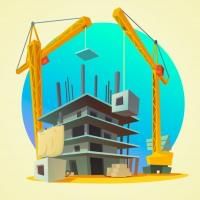Civil Engineering (CE) Exam > Civil Engineering (CE) Questions > The phenomenon of producing higher stresses n...
Start Learning for Free
The phenomenon of producing higher stresses near the junction of a web and lower stresses at points away from the web of a steel beam is known as _____.
- a)shear lag
- b)moment of resistance
- c)elastic critical moment
- d)lateral buckling
Correct answer is option 'A'. Can you explain this answer?
Most Upvoted Answer
The phenomenon of producing higher stresses near the junction of a web...
Shear lag:
- The phenomenon of producing higher stresses near the junction of a web and lower stresses at points away from the web of a steel beam is known as shear lag.
- Shear lag occurs due to the non-uniform distribution of forces across the cross-section of the beam.
Free Test
FREE
| Start Free Test |
Community Answer
The phenomenon of producing higher stresses near the junction of a web...
Shear Lag
Shear lag is the phenomenon in which higher stresses are produced near the junction of a web and lower stresses are observed at points away from the web of a steel beam. This effect occurs due to the unequal distribution of forces along the length of the beam.
Causes of Shear Lag
Several factors contribute to the occurrence of shear lag in steel beams:
1. Transverse Force Distribution: When a transverse force, such as a bending moment, is applied to a steel beam, the force is not evenly distributed across the entire width of the beam. The load is primarily carried by the top and bottom flanges of the beam, with minimal load transfer to the web.
2. Deformation of the Beam: As the beam undergoes deformation under load, the top and bottom flanges experience elongation or contraction, while the web remains relatively unaffected. This difference in deformation between the flanges and the web leads to the development of shear lag.
Effects of Shear Lag
The presence of shear lag in a steel beam can have several consequences:
1. Higher Stresses: The concentration of forces near the web junction results in higher stresses in that region compared to other areas of the beam. This can lead to localized deformation or failure.
2. Reduced Load Carrying Capacity: The unequal distribution of forces reduces the load carrying capacity of the beam. This means that the beam may not be able to support the expected loads, which can lead to structural instability.
3. Increased Deflection: Shear lag can also cause increased deflection in the beam. The higher stresses near the web junction cause greater deformation in that region, resulting in additional deflection of the beam.
Prevention and Mitigation
To minimize the effects of shear lag in steel beams, several design considerations can be implemented:
1. Stiffeners: Adding stiffeners to the web of the beam can help distribute the forces more evenly, reducing the concentration of stresses near the web junction.
2. Increased Web Thickness: Increasing the thickness of the web can improve its load-carrying capacity and reduce the effects of shear lag.
3. Proper Load Distribution: Designers should consider the distribution of forces and ensure that loads are applied in a manner that minimizes shear lag. This can help optimize the performance and stability of the beam.
By understanding the phenomenon of shear lag and implementing appropriate design measures, engineers can ensure the safe and efficient performance of steel beams in structural applications.
Shear lag is the phenomenon in which higher stresses are produced near the junction of a web and lower stresses are observed at points away from the web of a steel beam. This effect occurs due to the unequal distribution of forces along the length of the beam.
Causes of Shear Lag
Several factors contribute to the occurrence of shear lag in steel beams:
1. Transverse Force Distribution: When a transverse force, such as a bending moment, is applied to a steel beam, the force is not evenly distributed across the entire width of the beam. The load is primarily carried by the top and bottom flanges of the beam, with minimal load transfer to the web.
2. Deformation of the Beam: As the beam undergoes deformation under load, the top and bottom flanges experience elongation or contraction, while the web remains relatively unaffected. This difference in deformation between the flanges and the web leads to the development of shear lag.
Effects of Shear Lag
The presence of shear lag in a steel beam can have several consequences:
1. Higher Stresses: The concentration of forces near the web junction results in higher stresses in that region compared to other areas of the beam. This can lead to localized deformation or failure.
2. Reduced Load Carrying Capacity: The unequal distribution of forces reduces the load carrying capacity of the beam. This means that the beam may not be able to support the expected loads, which can lead to structural instability.
3. Increased Deflection: Shear lag can also cause increased deflection in the beam. The higher stresses near the web junction cause greater deformation in that region, resulting in additional deflection of the beam.
Prevention and Mitigation
To minimize the effects of shear lag in steel beams, several design considerations can be implemented:
1. Stiffeners: Adding stiffeners to the web of the beam can help distribute the forces more evenly, reducing the concentration of stresses near the web junction.
2. Increased Web Thickness: Increasing the thickness of the web can improve its load-carrying capacity and reduce the effects of shear lag.
3. Proper Load Distribution: Designers should consider the distribution of forces and ensure that loads are applied in a manner that minimizes shear lag. This can help optimize the performance and stability of the beam.
By understanding the phenomenon of shear lag and implementing appropriate design measures, engineers can ensure the safe and efficient performance of steel beams in structural applications.

|
Explore Courses for Civil Engineering (CE) exam
|

|
Question Description
The phenomenon of producing higher stresses near the junction of a web and lower stresses at points away from the web of a steel beam is known as _____.a)shear lagb)moment of resistancec)elastic critical momentd)lateral bucklingCorrect answer is option 'A'. Can you explain this answer? for Civil Engineering (CE) 2025 is part of Civil Engineering (CE) preparation. The Question and answers have been prepared according to the Civil Engineering (CE) exam syllabus. Information about The phenomenon of producing higher stresses near the junction of a web and lower stresses at points away from the web of a steel beam is known as _____.a)shear lagb)moment of resistancec)elastic critical momentd)lateral bucklingCorrect answer is option 'A'. Can you explain this answer? covers all topics & solutions for Civil Engineering (CE) 2025 Exam. Find important definitions, questions, meanings, examples, exercises and tests below for The phenomenon of producing higher stresses near the junction of a web and lower stresses at points away from the web of a steel beam is known as _____.a)shear lagb)moment of resistancec)elastic critical momentd)lateral bucklingCorrect answer is option 'A'. Can you explain this answer?.
The phenomenon of producing higher stresses near the junction of a web and lower stresses at points away from the web of a steel beam is known as _____.a)shear lagb)moment of resistancec)elastic critical momentd)lateral bucklingCorrect answer is option 'A'. Can you explain this answer? for Civil Engineering (CE) 2025 is part of Civil Engineering (CE) preparation. The Question and answers have been prepared according to the Civil Engineering (CE) exam syllabus. Information about The phenomenon of producing higher stresses near the junction of a web and lower stresses at points away from the web of a steel beam is known as _____.a)shear lagb)moment of resistancec)elastic critical momentd)lateral bucklingCorrect answer is option 'A'. Can you explain this answer? covers all topics & solutions for Civil Engineering (CE) 2025 Exam. Find important definitions, questions, meanings, examples, exercises and tests below for The phenomenon of producing higher stresses near the junction of a web and lower stresses at points away from the web of a steel beam is known as _____.a)shear lagb)moment of resistancec)elastic critical momentd)lateral bucklingCorrect answer is option 'A'. Can you explain this answer?.
Solutions for The phenomenon of producing higher stresses near the junction of a web and lower stresses at points away from the web of a steel beam is known as _____.a)shear lagb)moment of resistancec)elastic critical momentd)lateral bucklingCorrect answer is option 'A'. Can you explain this answer? in English & in Hindi are available as part of our courses for Civil Engineering (CE).
Download more important topics, notes, lectures and mock test series for Civil Engineering (CE) Exam by signing up for free.
Here you can find the meaning of The phenomenon of producing higher stresses near the junction of a web and lower stresses at points away from the web of a steel beam is known as _____.a)shear lagb)moment of resistancec)elastic critical momentd)lateral bucklingCorrect answer is option 'A'. Can you explain this answer? defined & explained in the simplest way possible. Besides giving the explanation of
The phenomenon of producing higher stresses near the junction of a web and lower stresses at points away from the web of a steel beam is known as _____.a)shear lagb)moment of resistancec)elastic critical momentd)lateral bucklingCorrect answer is option 'A'. Can you explain this answer?, a detailed solution for The phenomenon of producing higher stresses near the junction of a web and lower stresses at points away from the web of a steel beam is known as _____.a)shear lagb)moment of resistancec)elastic critical momentd)lateral bucklingCorrect answer is option 'A'. Can you explain this answer? has been provided alongside types of The phenomenon of producing higher stresses near the junction of a web and lower stresses at points away from the web of a steel beam is known as _____.a)shear lagb)moment of resistancec)elastic critical momentd)lateral bucklingCorrect answer is option 'A'. Can you explain this answer? theory, EduRev gives you an
ample number of questions to practice The phenomenon of producing higher stresses near the junction of a web and lower stresses at points away from the web of a steel beam is known as _____.a)shear lagb)moment of resistancec)elastic critical momentd)lateral bucklingCorrect answer is option 'A'. Can you explain this answer? tests, examples and also practice Civil Engineering (CE) tests.

|
Explore Courses for Civil Engineering (CE) exam
|

|
Signup for Free!
Signup to see your scores go up within 7 days! Learn & Practice with 1000+ FREE Notes, Videos & Tests.


















